
Despite a high dollar and its effect on exports, the Ontario greenhouse
vegetable sector is more than holding its own. Some 60 acres were added
last year, bringing the total acreage in the province to 1,919 acres.
Despite a high dollar and its effect on exports, the Ontario greenhouse vegetable sector is more than holding its own. Some 60 acres were added last year, bringing the total acreage in the province to 1,919 acres. There are 224 growers in the province, who annually produce nearly 250 million English cucumbers, over 130 million pounds of bell peppers, and over 380 million pounds of tomatoes, according to the Ontario Greenhouse Vegetable Growers (OGVG).
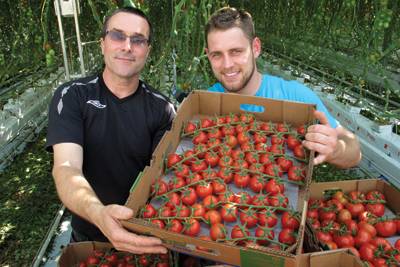 |
| Growers Harry Stigter and Tyler Clark with cocktail tomato clusters. Advertisement
|
Tomatoes represent 41 per cent of production, followed by peppers (32 per cent) and cucumbers (27 per cent). More than 70 per cent of Ontario’s greenhouse vegetable produce is exported to the U.S.
Last year’s expansion was about evenly split between tomatoes and peppers. The majority of expansion in recent years has been in peppers.
The coffee shop talk by growers often references energy prices or alternative fuels.
“The price of natural gas has come down in recent years,” says Shalin Khosla, greenhouse vegetable specialist with the Ontario Ministry of Agriculture, Food and Rural Affairs, “but growers still need to be concerned because the general pricing trend for energy has been upwards.”
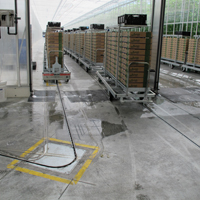 |
|
| The unmanned cart transport system at Nature Fresh Farms
|
Growers are looking at techniques to improve production using the same amount of energy. Greenhouse climate management software plays a major role in helping them achieve this goal.
One energy management strategy involves the placement of a temporary energy screen (2 mil) plastic sheet with perforations over young crops, primarily tomatoes and peppers. It provides another layer of insulation, easing heating requirements in the greenhouse.
As plants grow larger, there’s more transpiration, so the temporary screen has to be removed to allow better climate management with normal venting systems. “You have to learn to use these covers properly,” says Khosla, “because the climate in the greenhouse with the temporary screen has changed, and you have to adjust accordingly.”
An increasing number of growers are looking to glass with their expansion plans. The price of glass has come down at the same time double poly prices have increased.
The main advantage of glass is earlier crop development, meaning growers can start harvesting about a week earlier. And that’s good news if you’re trying to get into the market earlier when prices are higher.
Equipped with energy curtains, glass is just about as energy efficient as double poly and more energy efficient when managing the microclimate in the greenhouse.
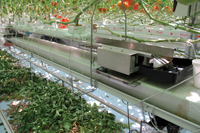 |
|
| A crop scale at Nature Fresh Farms.
|
But whatever the structure, growers are looking for improved diffused light characteristics in the covering, which means better distribution of light within the crop canopy, and that translates into better overall production.
And speaking of structures, things are quite literally looking up for growers. There was a time not so long ago when the standard height was about 10 feet under the gutter. Now, the new structures are 21 feet, with some at 25 feet under the gutter.
“The taller greenhouse improves greenhouse climate management in both summer and winter,” says Khosla. You don’t experience the effects of outside temperatures nearly as much as with shorter greenhouses. “The better you can control the greenhouse environment, the better the crop response.”
One farm in the province is using supplementary lighting to grow cucumbers year-round. Considerable research on supplementary lighting has been carried out – and is continuing to be studied, including a look at LEDs – at the Greenhouse and Processing Crops Research Centre in nearby Harrow.
IMPRESSIVE AUTOMATION
■ As for automation, a quick tour of the tomato packing facilities at Nature Fresh Farms in Leamington illustrates some of the latest labour-saving systems. Included is an automated internal unmanned transport system for moving carts via an infloor chain track, along with automated tray destacking, produce weighing and tray stacking units.
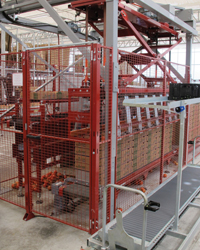 |
|
| A destacking unit in the tomato packing house at Nature Fresh Farms.
|
The automation means they pack produce from 30 acres with only 10 people. It would normally require two to three times as many people in a traditional packing house.
It also means the vegetables are only handled twice: once in harvesting, and once during packing.
In addition to 32 acres of tomatoes, Nature Fresh has 66 acres of peppers. An additional 30 acres of greenhouse construction is planned for this year. The new greenhouses will be 25 feet under the gutter with many energy and labour saving technologies.
Nature Fresh also incorporates a traceability program in which employees use PDAs to log in for each crop task. In this way, all crop inputs, along with harvesting information, are recorded. Every vegetable can be easily traced.
In addition to traceability, the system allows for a piecework pay system. It’s a great incentive program for workers, who can earn much more than if paid a traditional hourly rate. Growers are paying more per hour, which the employees appreciate, and the increased productivity means lower overall labour costs at the end of the season.
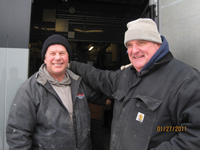 |
|
| Seacliff Energy managers Dennis Dick, at left, and Roger Tiessen. PHOTO COURTESY SEACLIFF ENERGY |
Water resource management is also important for growers, and Nature Fresh utilizes a crop scale system. A scale is placed within each zone. Irrigation is optimized, as the scale accurately records water loss in the plants. This results in the crop getting exactly what it needs in terms of irrigation.
ALTERNATIVE FUELS
■ One of the newest alternative energy projects involves a state-of-the-art anaerobic digestion facility in Leamington.
Seacliff Energy Ltd. is fine-tuning its eight-acre facility that will utilize organic material to produce methane gas, which will then be used in an onsite cogen system to produce electricity for the provincial power grid. The heat will be used in the adjacent Pelee Hydroponics greenhouses.
 |
|
| Installation of an impermeable gas membrane on a digester tank last fall. PHOTO COURTESY SEACLIFF ENERGY |
Dennis Dick, owner of Pelee Hydroponics (which is leasing out its space for organic tomato production), and Roger Tiessen, a longtime area businessman, are project partners in Seacliff Energy, along with Gemini Power Corp. and Alpenglow Energy Inc..
(For a history of the project, visit the June 2010 section in our Past Issues website archives at www.greenhousecanada.com . The feature was called, “Conservation focus grows.”)
The property took a direct hit from last summer’s tornado, which flattened the greenhouses and caused some damage to the digester facility. Cleanup and rebuilding operations put the project about a month behind schedule.
Most anaerobic systems have a single tank. The Seacliff system also includes a pre-treatment unit. “Pre-treatment is now all the rage in Europe,” says Dick.
Anaerobic digestion occurs when organic materials break down in an oxygen-free environment. The gas that is produced is called biogas, which is 50 to 75 per cent methane. This methane is similar to natural gas and can be used to run an engine to generate electricity and heat.
The project is an environmental winner. It’s about as closed an energy loop as you can get.
- The system diverts organic material that previously was primarily landfilled. The Leamington area has a number of large food and beverage processing plants, as well as a large concentration of production greenhouses, that generate byproducts that currently are required to be spread on fields, treated in odiferous sewage lagoons, and/or delivered to landfill sites.
- It captures methane that otherwise would have been released by that organic material.
- It produces baseline electricity for the grid.
- The cogen’s heat is diverted into the greenhouse.
- The end-byproduct can be used as a fertilizer. “Through this entire process,” says Dick, “no nutrients are lost.”
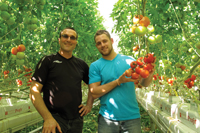
|
|
| Harry Stigter and Harry Clark with cluster tomatoes at Nature Fresh Farms.
|
Seacliff Energy can process 100 to 120 tons of organic material a day and generate 1.6 megawatts of electricity, about enough power to meet the needs of 1,400 to 1,600 homes.
Dick is a board member with the Agri-energy Producers’ Association of Ontario. The APAO says that combining food waste with manure biogas potential would mean some 250 megawatts of continuous biogas power production is possible in Ontario, about enough to power between 150,000 and 200,000 average households.
The company is hoping to expand with a second 1.6-megawatt system on the site. However, provincial approval is required, and a number of alternative energy proposals are in the queue. “We’re shovel-ready to go,” says Dick. ■
Print this page